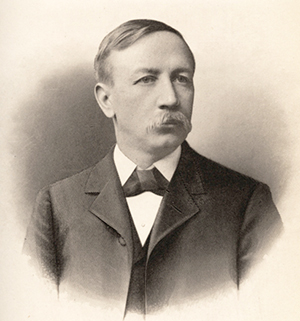Fries, Henry Elias
22 Sept. 1857–3 Mar. 1949
 Henry Elias Fries, industrialist, third son of Francis Levin and Lisetta Maria Vogler Fries, was born in Salem and began his education at Salem Boys School. At age seventeen he enrolled at Davidson College, but failing eyesight forced his departure after three years without receiving a degree. He then became manager of Wachovia Mills, a subsidiary of F and H Fries Manufacturing Company, which produced flour. In 1881, he married Rosa Mickey of Salem; they had one daughter.
Henry Elias Fries, industrialist, third son of Francis Levin and Lisetta Maria Vogler Fries, was born in Salem and began his education at Salem Boys School. At age seventeen he enrolled at Davidson College, but failing eyesight forced his departure after three years without receiving a degree. He then became manager of Wachovia Mills, a subsidiary of F and H Fries Manufacturing Company, which produced flour. In 1881, he married Rosa Mickey of Salem; they had one daughter.
An active promoter and organizer, Fries was secretary of the State Industrial Exposition held in Raleigh in 1884 and in the following year organized the Southside Cotton Mill in Winston, of which he became president. In 1887, he filled one term as Forsyth County representative to the North Carolina General Assembly and was for years a Democratic party national committeeman. He also served as mayor of Salem for three terms; as a member of the Forsyth County Board of Education, which undertook the building of new schoolhouses for the entire system; and as trustee of Slater Industrial and Normal School (later Winston-Salem State University). He was instrumental in establishing the North Carolina College of Agriculture and Mechanic Arts as one of its three-man organizational committee and was a member of the board of trustees for ten years.
In 1897, Fries pioneered in electrical development when he founded the Fries Manufacturing and Power Company, which built a hydroelectric dam on the Yadkin River to supply the mills of Winston-Salem with electricity, the first long-distance transmission established in North Carolina. By the time this project was sold in 1913, Fries was operating an electric streetcar system and supplying homes as well as factories with electricity. As a member of the town board of Salem, he was credited with being one of the primary advocates of the consolidation of Winston and Salem. He helped organize the Winston-Salem Chamber of Commerce and a Red Cross chapter, and he served many years in the Rotary Club, becoming its president in 1935.
Because there was no rail link from Winston or Salem to the south, Fries joined with his brother Francis in 1909 to form the Winston-Salem Southbound Railway creating a link from Winston-Salem to Wadesboro. Henry Fries served as the railroad's president until his death. He also headed the Forsyth Manufacturing Company and Arista Mills.
Besides his involvement with the beginnings of what is now North Carolina State University, Fries served on the State Board of Agriculture, in which he was known for pioneering in guernsey cattle breeding, and on the State Geological Board.
Fries never ceased to be an enthusiastic promoter and worker. He died at his desk in the Reynolds Building of a coronary thrombosis at age ninety-two and was buried in the Salem Cemetery. Probably more than any one person, Fries paved the way for the modern industrial center of Winston-Salem.
References:
Death Certificates of Forsyth County (Forsyth County Courthouse, Winston-Salem).
Henry E. Fries Papers (Manuscript Department, Library, Duke University, Durham).
North Carolina Biography, vol. 5 (1919).
North Carolina General Assembly, Legislative Sketchbook (1887).
Winston-Salem Journal and Sentinel, 4 Mar. 1949, 11 Oct. 1970.
Additional Resources:
"Henry Elias Fries Letters" call #: DC0029s. Archives and Special Collections, Davidson College. http://sites.davidson.edu/archives/digital-collections/henry-elias-fries-letters (accessed April 16, 2013).
Blair, W.A. "Henry Elias Fries." Biographical History of North Carolina from Colonial Times to the Present Volume 3. Greensboro, N.C.: C. L. Van Noppen, 1906. 152-156. http://books.google.com/books?id=D0zcsZEFkNAC&lpg=PA153&ots=BHPrcdiCYO&pg=PA152#v=onepage&q&f=false (accessed April 16, 2013).
"Fries Manufacturing And Power Co.." N.C. Highway Historical Marker J-70, N.C. Office of Archives & History. https://www.ncdcr.gov/about/history/division-historical-resources/nc-highway-historical-marker-program/Markers.aspx?sp=Markers&k=Markers&sv=J-70 (accessed April 16, 2013).
"Fries Auditorium." C. G. O'Kelly Library. Winston-Salem State University. 2010. http://www.wssu.edu/cg-okelly-library/services/archives/core/buildings/fries-auditorium-m.aspx (accessed April 16, 2013).
"NC group pushes to save historic power station" Winston-Salem Journal, January 7, 2013. Preservation North Carolina. http://www.presnc.org/Features/NC-group-pushes-to-save-historic-power-station (accessed April 16, 2013).
O'Bannon, Patrick W. "Fries Manufacturing & Power Company - Idols Station NC-9." Washington, D. C.: Heritage Conservation and Recreation Serivce, Department of the Interior. 1977 https://www.loc.gov/item/nc0190/ (accessed April 16, 2013).
Image Credits:
E.G. Williams and Bro. "Henry Elias Fries." Biographical History of North Carolina; From Colonial Times to the Present. 1905. Forsyth County Public Library. WakeSpace digital archive, Wake Forest University.http://hdl.handle.net/10339/31399http://hdl.handle.net/10339/31399http://hdl.handle.net/10339/31399 (accessed April 16, 2013).
1 January 1986 | Kirkman, Roger N.